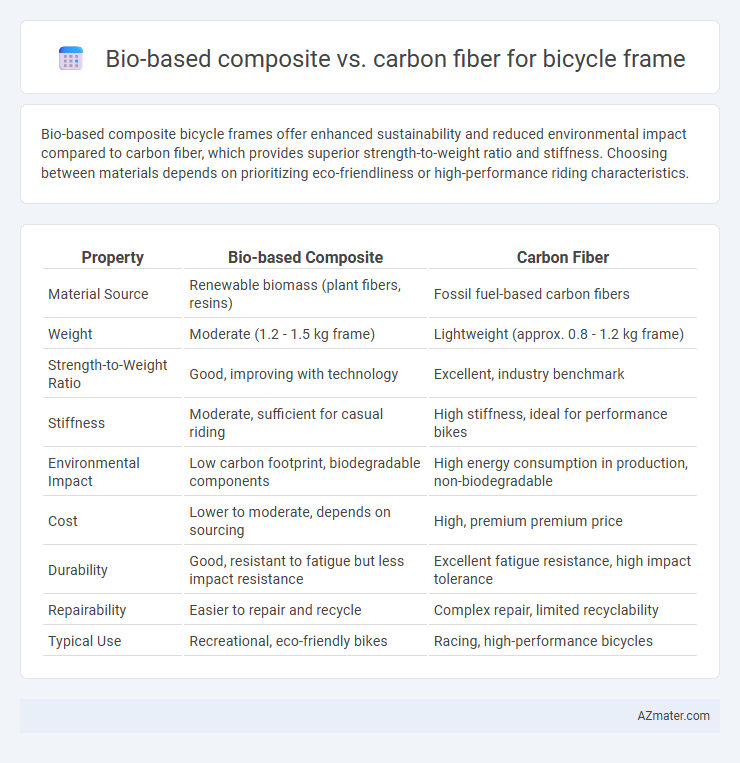Bio-based composite bicycle frames offer enhanced sustainability and reduced environmental impact compared to carbon fiber, which provides superior strength-to-weight ratio and stiffness. Choosing between materials depends on prioritizing eco-friendliness or high-performance riding characteristics.
Table of Comparison
| Property | Bio-based Composite | Carbon Fiber |
|---|---|---|
| Material Source | Renewable biomass (plant fibers, resins) | Fossil fuel-based carbon fibers |
| Weight | Moderate (1.2 - 1.5 kg frame) | Lightweight (approx. 0.8 - 1.2 kg frame) |
| Strength-to-Weight Ratio | Good, improving with technology | Excellent, industry benchmark |
| Stiffness | Moderate, sufficient for casual riding | High stiffness, ideal for performance bikes |
| Environmental Impact | Low carbon footprint, biodegradable components | High energy consumption in production, non-biodegradable |
| Cost | Lower to moderate, depends on sourcing | High, premium premium price |
| Durability | Good, resistant to fatigue but less impact resistance | Excellent fatigue resistance, high impact tolerance |
| Repairability | Easier to repair and recycle | Complex repair, limited recyclability |
| Typical Use | Recreational, eco-friendly bikes | Racing, high-performance bicycles |
Introduction to Bicycle Frame Materials
Bicycle frame materials significantly impact performance, durability, and sustainability, with bio-based composites and carbon fiber as prominent options. Carbon fiber offers exceptional strength-to-weight ratio and stiffness, making it ideal for high-performance bicycles, while bio-based composites utilize renewable materials like natural fibers and resins, promoting environmental sustainability. Recent advancements in bio-based composites aim to match carbon fiber's mechanical properties, presenting a promising alternative for eco-friendly bicycle manufacturing.
What Are Bio-Based Composites?
Bio-based composites for bicycle frames consist of natural fibers such as flax, hemp, or bamboo embedded in bio-resins derived from renewable sources like vegetable oils or starch. These composites offer a sustainable alternative to traditional carbon fiber by reducing carbon footprint and reliance on fossil fuels, while maintaining competitive strength and stiffness. Innovations in bio-based composites enhance impact resistance and vibration dampening, providing eco-friendly performance benefits in bicycle frame manufacturing.
Understanding Carbon Fiber in Cycling
Carbon fiber offers exceptional strength-to-weight ratio, making it the preferred material for high-performance bicycle frames due to its stiffness and lightweight properties. Bio-based composites, derived from renewable resources like plant fibers, provide sustainability benefits but generally lack the same tensile strength and durability as carbon fiber. Understanding the mechanical behavior and fatigue resistance of carbon fiber helps cyclists optimize frame performance and longevity in demanding riding conditions.
Environmental Impact: Bio-Based vs Carbon Fiber
Bio-based composite bicycle frames significantly reduce environmental impact by utilizing renewable resources and decreasing carbon emissions during production compared to traditional carbon fiber frames derived from fossil fuels. The biodegradability and recyclability of bio-based composites contribute to lower landfill waste and facilitate a circular economy in the cycling industry. Carbon fiber frames, while offering superior strength-to-weight ratios, involve energy-intensive manufacturing processes and pose challenges in recycling, leading to greater environmental degradation.
Performance Characteristics Compared
Bio-based composites offer lightweight and sustainable alternatives for bicycle frames, providing competitive tensile strength and impact resistance but generally lower stiffness compared to carbon fiber. Carbon fiber frames excel in high stiffness-to-weight ratio, enhancing aerodynamic efficiency and responsiveness, making them preferred in professional cycling. While bio-based composites improve environmental impact and vibration damping, carbon fiber remains superior in ultimate performance and durability under extreme cycling conditions.
Durability and Longevity of Both Materials
Bio-based composites for bicycle frames offer substantial durability with resistance to corrosion and fatigue, though they generally exhibit lower impact strength compared to carbon fiber. Carbon fiber frames excel in longevity due to high tensile strength and stiffness, maintaining structural integrity under repeated stress and extreme conditions. Both materials benefit from advanced manufacturing techniques that enhance durability, but carbon fiber typically outperforms bio-based composites in lifespan and long-term performance for high-demand cycling applications.
Weight and Stiffness Analysis
Bio-based composites for bicycle frames offer a lightweight alternative with densities typically ranging between 1.2 to 1.5 g/cm3, whereas carbon fiber composites have densities around 1.6 g/cm3, contributing to overall frame weight differences. In stiffness analysis, carbon fiber exhibits superior tensile modulus values of approximately 70-150 GPa, enabling higher rigidity and responsive handling compared to bio-based composites, which generally range from 10 to 30 GPa depending on fiber content. Weight-to-stiffness ratios favor carbon fiber for performance applications, while bio-based composites provide satisfactory stiffness with the advantage of sustainability and potential damping benefits.
Cost Considerations for Manufacturers and Riders
Bio-based composite bicycle frames offer a cost advantage for manufacturers due to lower raw material expenses and simpler processing compared to carbon fiber, which involves expensive precursor materials and energy-intensive fabrication. Riders generally face reduced frame prices with bio-based composites, making sustainable options more accessible without compromising durability. However, carbon fiber frames maintain a premium price point driven by their superior strength-to-weight ratio and established market demand.
Market Trends and Future Developments
Bio-based composites are gaining traction in the bicycle frame market due to their sustainability and reduced environmental impact, appealing to eco-conscious consumers and manufacturers. Carbon fiber remains dominant for high-performance bike frames because of its superior strength-to-weight ratio and stiffness, driving continuous innovation in manufacturing techniques to reduce costs and improve recyclability. Future developments are expected to enhance bio-based composite durability and integration with carbon fiber layers, promoting hybrid frames that balance environmental benefits with high performance.
Which Material Is Right for Cyclists?
Bio-based composite bicycle frames offer lightweight, eco-friendly alternatives with high impact resistance suitable for casual and environmentally conscious cyclists. Carbon fiber frames provide superior stiffness, strength-to-weight ratio, and aerodynamic advantage favored by competitive riders seeking maximum performance. Cyclists prioritizing sustainability and comfort may prefer bio-based composites, while those focused on speed and responsiveness typically choose carbon fiber.

Infographic: Bio-based composite vs Carbon fiber for Bicycle frame
 azmater.com
azmater.com